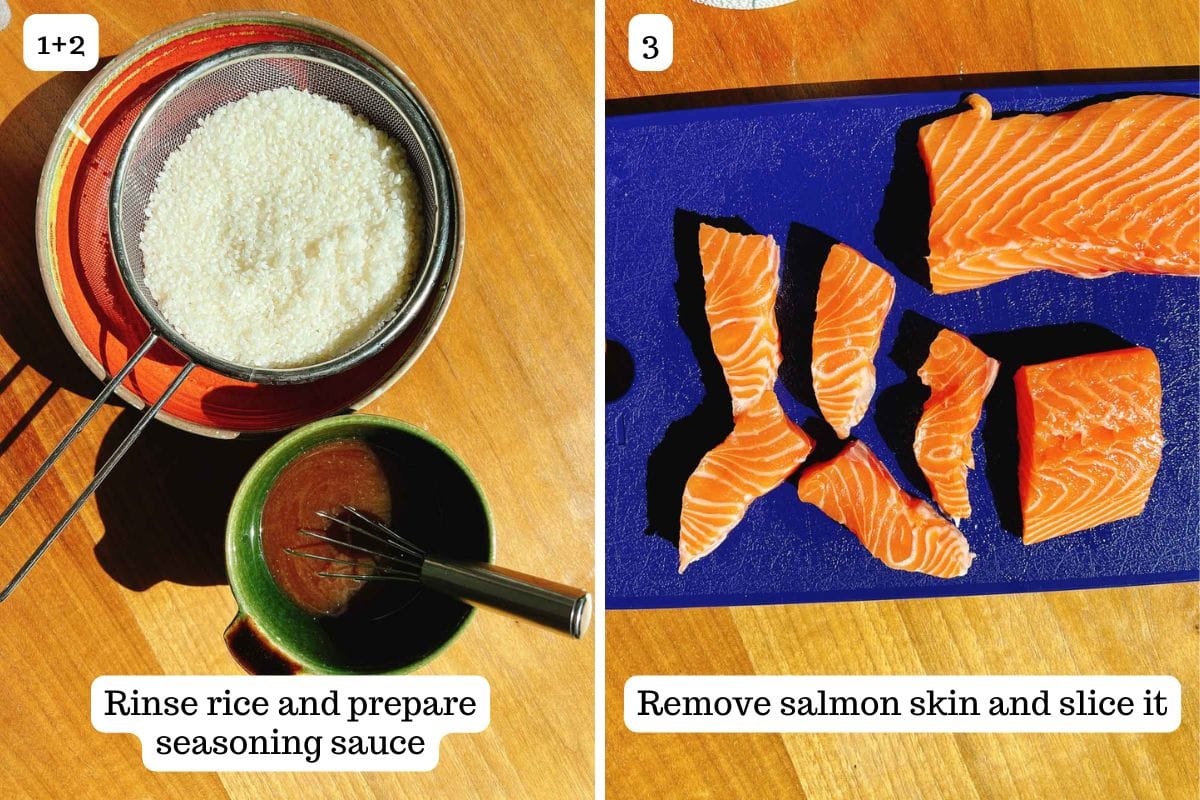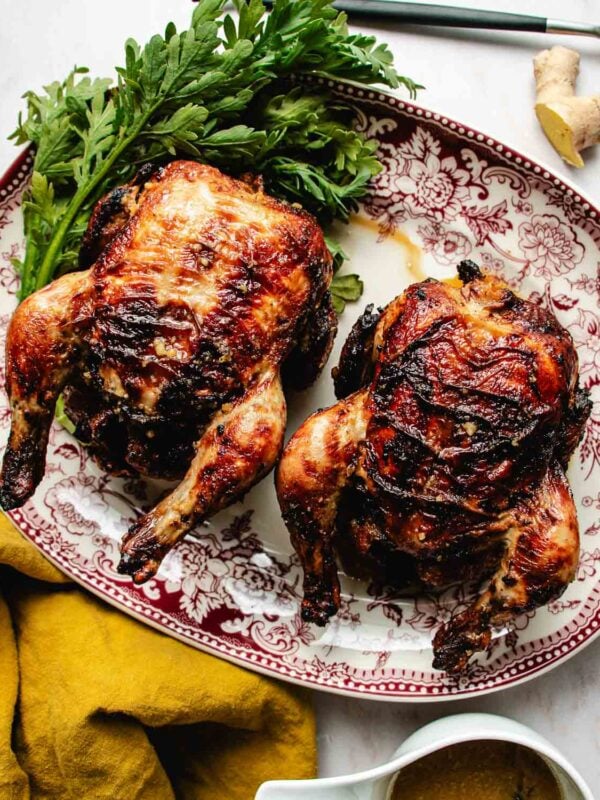This post may contain affiliate links. Please read our disclosure policy.
This one pot salmon and rice recipe is a light and healthy Japanese-inspired dish that’s so easy to make! The rice is perfectly cooked and the bottom crisps up beautifully, like the golden layer in a Spanish paella. The salmon is tender and flaky every time.
This dish is packed with umami flavor! It reminds me of the rich, smoky-sweet taste of Japanese unagi. It’s a fuss-free recipe perfect for weeknight dinners or meal prep. If you love salmon, try my Thai salmon fried rice, too!

Table of Contents
Ingredients
This Japanese salmon rice is packed with simple Asian flavors, perfectly balancing salty umami with a hint of tanginess. It’s a one-pot dish where the rice cooks in a seasoned broth for extra flavor, making it easy and delicious!

- Short-grain white rice
- Substitution: Medium-grain white rice or jasmine rice also works well.
- Chicken stock: Used in place of water for extra flavorful rice.
- Oyster sauce: Added to the stock and used as a garnish for depth of flavor.
- Shitake Mushroom seasoning: For even more flavor in the rice.
- Substitution: Chicken bullion powder or Japanese dashi powder
- Mirin: Added to the stock before cooking the rice
- Substitution: Sake works too.
- Soy sauce: Another flavor additive for a deep umami taste in the rice.
- Salmon filet: Center-cut, boneless and skinless.
- Substitution: Frozen salmon that’s been thawed overnight.
- Rice vinegar: Used to season the rice for a Japanese sushi rice flavor.
- Coarse sea salt (optional) to taste
- Scallions
- Optional garnish: Toasted black and white sesame seeds for color and crunch and Japanese furikake for added saltiness and umami flavor.
- Lemon: Sliced and served as a garnish.
- Seaweed snacks: Optional for serving.
Tools:
- 12-15 inch (30-38cm) wide cast iron skillet/braiser with a lid
Best types of rice to go with salmon
Short-grain white rice is my top pick for this salmon fish recipe. Its tender, slightly chewy texture is perfect for absorbing all the rich flavors in the stock.
Medium-grain white rice or jasmine rice are also great options. Avoid long-grain varieties like basmati—the texture is too firm, and it won’t soak up the flavors as well.
How to make salmon and rice
This one-pot rice with salmon is easy to make! Cook the rice al dente in seasoned chicken stock, then add the salmon to finish. Garnish with tasty toppings for an extra boost of flavor and texture.

- Rinse the Rice: Measure the rice with a scale, rinse 2-3 times until the water runs mostly clear, and drain.
- Mix Stock and Seasonings: Combine chicken stock, oyster sauce, bouillon powder, mirin, and soy sauce in a small bowl.
- Prepare the Salmon: Skin and debone if needed. Slice into 2.5-inch (6 cm) by 0.5-inch (1.25 cm) pieces.

- Cook the Rice: Spread rice evenly in a 12-15 inch (30-38 cm) skillet. Add liquids, stir to level, and cover with the lid slightly ajar. Boil gently over medium-high heat for 5-6 minutes.
- Add salmon: Reduce heat to low, arrange salmon on the rice, and cover. Cook for 12-15 minutes until the rice absorbs the liquid.

- Check and Rest: Rice should be al dente with no excess liquid. If needed, simmer for another 5 minutes. Remove from heat and let rest, covered, for 15 minutes.
- Fluff and Adjust: Add rice vinegar, fluff rice and salmon gently, and adjust seasonings to taste.
- Garnish and Serve: Drizzle oyster sauce over salmon, then sprinkle scallions, sesame seeds, and furikake (if using). Add lemon slices. Serve warm with optional seaweed snacks for scooping.
Good to know
How much water to add to the pan?
This recipe uses a precise 1:1.33 rice-to-water ratio (300 grams of rice to 400 grams of stock), which is slightly higher than the typical ratio for cooking white rice. It creates the perfect texture and helps the rice absorb the stock’s seasonings. For the best results, use a kitchen scale to measure the rice and liquid.
- Standard Ratio: 1 cup of short-grain white rice to 1 ⅓ cups of liquid.
- This Recipe’s Ratio: 300 grams (about 1.5 cups) of short-grain white rice to 400 grams (about 1 ⅔ cups) of chicken stock.
Troubleshooting your rice
- If the rice is too firm: Add 25 grams (about 2 tablespoons) of water or stock. Cover and simmer on low heat for 5 minutes.
- If the rice is too mushy: This means there’s excess water in the pot. Partially cover the pot with the lid slightly ajar to let moisture escape. Simmer on low heat for 5-10 minutes, then check again.
Perfect rice
Pro tip: After resting the rice for 15 minutes with the lid on, the grains will soften in the center. Cooking the rice to an al dente texture before resting will help achieve the perfect end result.
What to serve with salmon fish rice
This simple one-pot meal can easily be turned into a yummy salmon rice bowl or be served as part of a larger, family-style meal. Here are some ideas for adding to this dish:
- Kimchi: Fresh, crunchy cucumber kimchi adds great flavor and texture. Or try my tangy, spicy bok choy kimchi for an extra kick!
- Pickles: My Asian pickled cucumbers are sweet, tangy, and lightly spicy. Pickled daikon is sweet and tangy, while Pickled garlic brings a bold flavor.
- Rice topping sauces: You can further season the dish with my gluten-free teriyaki sauce, Honey sriracha sauce, or this sweet and sour Vietnamese dipping sauce (nuoc cham).
- Other topping ideas: Top with edamame, avocado, fresh herbs, or your favorite vegetables.
ChihYu’s helpful notes
- Types of Rice: Short or medium-grain white rice works best for texture and flavor. Jasmine rice is a good alternative.
- Rice-to-liquid ratio: For the best results, use a 1:1.33 rice-to-water ratio. Measure 300 grams of rice and 400 grams of stock using a scale.
- Cookware: Use a 12-15 inch (30-38 cm) skillet or braiser with even heat distribution to prevent sticking.
- Let the rice rest with the lid on after cooking so the flavors can meld and the rice can finish cooking to the perfect texture.
- Meal prep: Store extra in the fridge for up to 4 days in airtight containers for meal prep boxes.
- Reheat leftovers in a skillet. Heat the rice and salmon together for a quick fried rice.
More salmon and rice dishes
Salmon with rice is a winning combination! If you can’t get enough, try some of my other salmon recipes with rice.
- Gochujang roasted salmon — A sweet and spicy healthy Asian salmon recipe with low carb cauliflower rice and gochujang glaze.
- Crispy rice sushi — Crunchy rice cakes topped with smoked salmon, creamy avocado, cucumbers, and my bang bang sauce.
- Salmon fried rice — An easy Thai style fried rice with loads of fresh lime and a touch of chiles.
- Salmon bowl — California style easy salmon bowl is perfect for all year round! (coming soon)

One pot salmon and rice recipe

Video
Ingredients
- 300 gram short grain white rice
- 400 gram chicken stock
- 1.5 tbsp oyster sauce plus extra for garnish
- 2 tsp shiitake mushroom seasoning chicken bouillon powder, or dashi powder
- 1 tbsp mirin or sake
- 1 tbsp soy sauce
- 1 lb center-cut salmon filet boneless and skinless
- 2 to 2.5 tbsp rice vinegar or to taste
- coarse sea salt to taste Optional
- 3 scallions sliced
- Sprinkle toasted black and white sesame seeds
- Sprinkle furikake optional
- Half one whole lemon sliced
- Seaweed snacks for serving (optional)
Equipment
- 1 wide casserole skillet or braiser with a lid 12-15 inch (30-38cm)
Instructions
Rinse the Rice:
- Measure the rice using a kitchen scale. Rinse the rice in a colander 2-3 times until the water runs mostly clear. Set aside to drain.
Combine Stock and Seasonings:
- In a cup, mix the chicken stock with oyster sauce, bouillon powder, mirin, and soy sauce.
Prepare the Salmon:
- If the salmon has skin, remove it. Slice the salmon into pieces about 2.5 inches (6 cm) long and 0.5 inch (1.25 cm) thick. Set aside.
Boil the Rice:
- Place the rinsed rice in a 12-15 inch (30-38 cm) casserole skillet or braiser. Spread the rice evenly, then pour in the seasoned stock. Level the rice again with the back of a spoon, cover the pot with the lid slightly ajar, and bring it to a gentle boil over medium-high heat for 5-6 minutes.
Add salmon and simmer:
- Reduce the heat to low. Arrange the salmon pieces on top of the rice in a single layer. Cover the pot tightly with the lid. Simmer on low for 12-15 minutes. Keep the lid on the entire time to ensure even cooking.
Check for Doneness:
- After simmering, quickly lift the lid and test the rice. If the grains are still firm in the center (al dente) or you see excess liquid, cover again and continue to simmer for another 5 minutes until the rice reaches an al dente texture and the liquid has been absorbed. Once done, turn off the heat.
Rest:
- Move the pot off the stove and let it rest with the lid on for 15 minutes. This allows the flavors to meld and the rice to settle.
Season, Fluff, and Adjust:
- Drizzle the rice with rice vinegar. Using a rice paddle, gently fluff the rice and the salmon by lifting from the bottom up. Taste, and add more salt or vinegar if needed. Aim for a less salty flavor, as the garnishes will add extra savoriness.
Garnish and Serve:
- Lightly drizzle additional oyster sauce on top, then sprinkle with scallions, sesame seeds, and furikake (if using). Add lemon slices for a fresh touch.
Serve Warm:
- Serve immediately, with optional seaweed snacks on the side. Use the seaweed to scoop up the salmon and rice for an extra layer of flavor.
Notes
- Important: For accurate measurements, use a kitchen weight scale to measure both the rice and the water.
- Rice-to-liquid ratio is: 1 cup of short-grain rice to 1 ⅓ cups of liquid. To be accurate:
- 300 grams (about 1.5 cups) of short-grain white rice: 400 grams (about 1 ⅔ cups) of chicken stock
- If making a larger batch – 400 grams (about 2 cups) of short-grain white rice: 533 grams (about 2 ¼ cups) of chicken stock
- This ratio (1:1.33) is slightly higher in liquid than a typical rice-to-water ratio (usually closer to 1:1 for short-grain rice), because of the absorption of flavors from the chicken stock and seasonings and the size of the pan (wide and flat). The rice will be in al dente texture for this recipe.
Nutrition
Nutrition information is automatically calculated, so should only be used as an approximation.













This has become my go to work lunch. Excellent fresh off the stove on Sunday night and reheats very well in the microwave (or stove if your workplace has one). The seaweed snacks are also a great pairing. Thanks!
Thank you, Patrick!
I loved this! I ate this for the next three days for lunch and was soooo happy. It is simple yet flavorful and so easy! I used seaweed sheets to eat it with and topped it with some hot sauce – yum yum YUM. I love your recipes and how your step by step instructions give me confidence when I am cooking. Thanks for the amazing (almost) week of great meals.
Ohhh I’m so happy to hear that. Also very glad to hear the step-by-step photos were helpful. Wonderful!
Very nice recipe ! Is there a way to cook it using a rice cooker ? Thanks !
It will be a different recipe though but I’m sure yes!
I was hosting a holiday potluck and made this. Everyone loved it. It was the perfect ratio of rice to salmon. Flavorful and easy to make. Now I’ve added your family dinner rotation.
Thank you so much for sharing and i’m so happy to hear that! Great party! :))
This one pot salmon rice is so good! We added broccoli florets toward the end of cooking and my kids love the drizzle of the oyster sauce on top. It reminds me of what we had in Japan – unagi rice bowl but with crisp rice at the bottom. A great dish to feed the crowd and the leftover makes great fried rice, too.
Thank you!